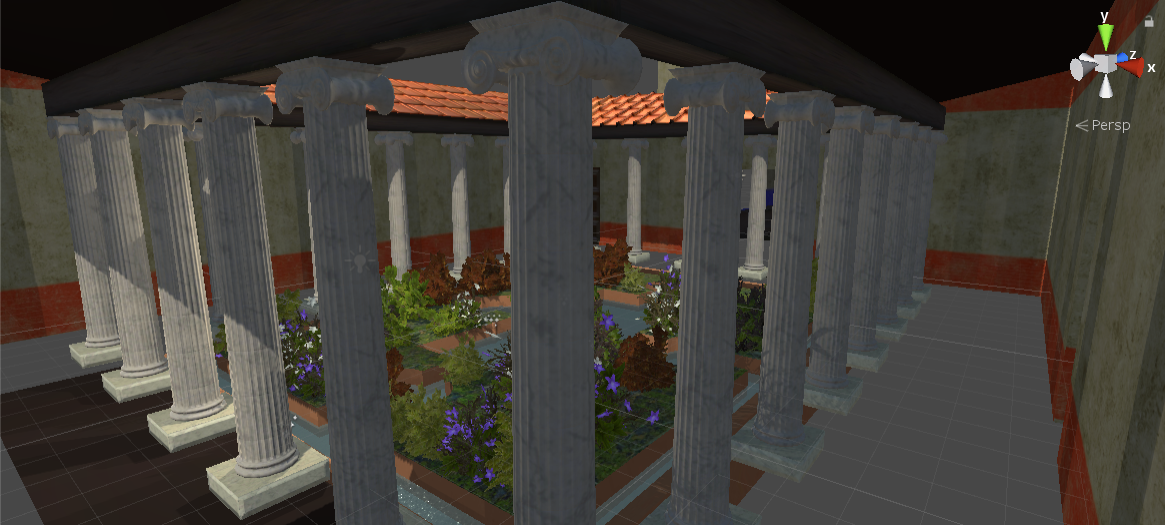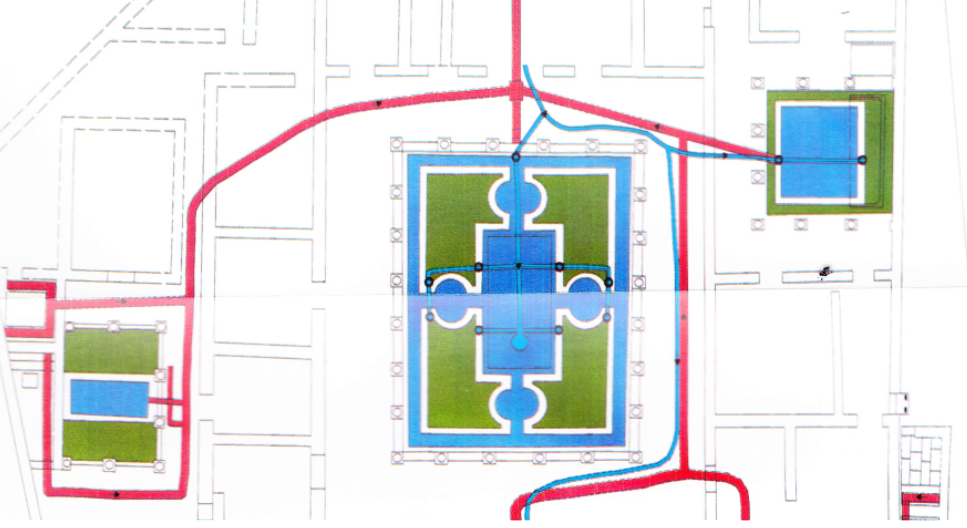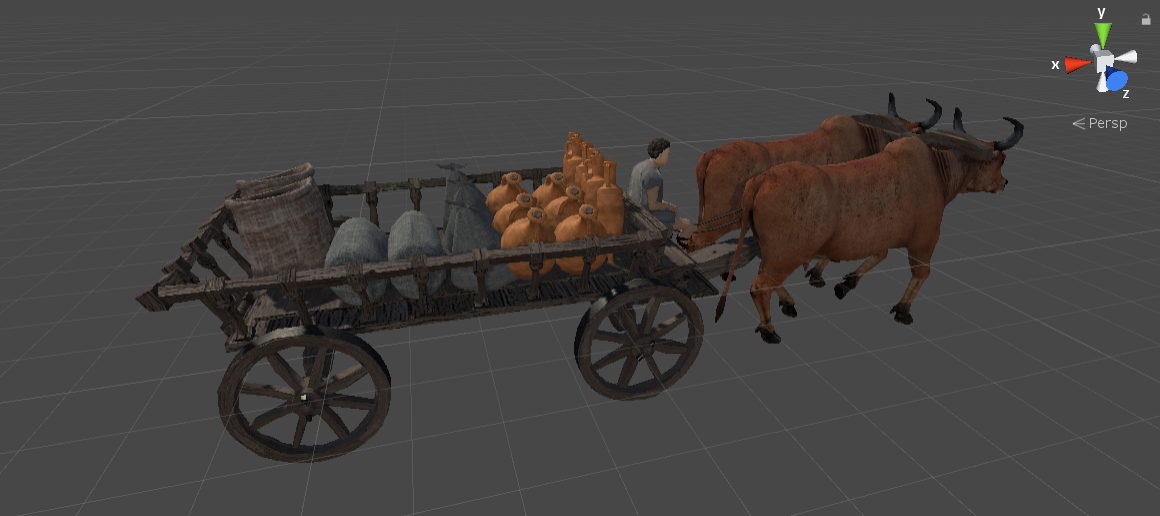SensiMAR: The visual Content

Over the last month, I have produced visual content to be on display for the SensiMAR experience. This data relates to the reconstruction of one part of the House of Cantaber, from Conimbriga. This article shows what was reconstructed, and why.
The place where SensiMAR will take place, as previously shown in this article, will occur at the entrance of the House of Cantaber.
This augmented reality experience will allow the user to be among the ruins and, at the same time, overlap the virtual content related to the ruins of the House of Cantaber. For the visual perception of this site, the virtual reconstruction includes reconstruction of the columns, the garden and the main walls, as well as the doors found in the peristyle surroundings.
 Figure 1 - Screenshot of SensiMAR app prototype, with some of the virtual elements that will be added to the experience.
Figure 1 - Screenshot of SensiMAR app prototype, with some of the virtual elements that will be added to the experience.
The user will be able to explore in a 360-degree environment, which means that this virtual content will surround the user. Starting from a 0-degree position, the user can explore the peristyle. When the visitor reaches a 180-degree position, they will see the main entrance of the house and a button that will allow them to play an animation.
 Figure 2 - Screenshot of SensiMAR app prototype, showing a button for interaction, during the augmented reality experience.
Figure 2 - Screenshot of SensiMAR app prototype, showing a button for interaction, during the augmented reality experience.
This animation is composed of the appearance of two romans walking and chatting with each other and, by a wagon that passes outside, on the road, carrying goods.
 Figure 3 - Screenshot of SensiMAR app prototype, where it is possible to observe the two Romans and the wagon passing.
Figure 3 - Screenshot of SensiMAR app prototype, where it is possible to observe the two Romans and the wagon passing.
The Columns
The columns from House of Cantaber are Ionic columns, as visible in figure 4. The Romans were very good at imitating marble with plaster, creating a realistic illusion of real marble, as represented in the figure. However, as we can see when visiting the ruins, these columns were made with bricks. The plaster is not preserved to observe the marble imitation as the illustration shows.
 Figure 4 - Screenshot of SensiMAR app prototype, having a closer look at the columns
Figure 4 - Screenshot of SensiMAR app prototype, having a closer look at the columns
The Garden
The garden was typically composed of different types of flowers. The idea of the Romans was to have flowers at different times of the year, depending on the species. Also, the abundance of water allowed a rich garden. According to literature, the flowers that could be found in Conimbriga could be Acanthus mollis, Lilium candidum, Chrysantemum carinatum, Mathiolla incana, Ísis germanica, and Rosa canina.
 Figure 5 - Screenshot of SensiMAR app prototype, with an overview of the garden.
Figure 5 - Screenshot of SensiMAR app prototype, with an overview of the garden.
Regarding the fountains, there were 9 fountains that should be working all together. These fountains are larger when compared to the fountains from the House of the Fountains, and they are displaced as picture 6 illustrates.
 Figure 6 - Footprint of the fountains found in House of Cantaber.
Figure 6 - Footprint of the fountains found in House of Cantaber.
The virtual fountains were created in Unity 3D, with a particle system for each fountain, and another particle system simulating the splash effects when the water coming from the fountain hits the ground.
All described elements in this section, apart from the fountains, were created using Maya Software or, in the case of the flowers, imported from a previous project, or downloaded from 3D libraries. The textures were created using Adobe Photoshop Software or downloaded from libraries and, then, edited with Adobe Photoshop Software. The texture of the water was created in Unity, with the intention of creating the illusion of movement of the water - by moving the texture itself. This feature was accomplished using a Script in Unity.
The animation
The animation is composed, as specified before, by two Romans walking and a wagon. This animation is triggered by the user who will touch a button saying “Touch to See animation”.
The Romans
The Romans appear from the right side, from behind a folding screen. These Romans are chatting with each other and, when they reach the entrance of the house, they will see the wagon that passes outside on the street. They stop and they wave at it. Afterward, they continue walking disappearing behind another folding screen on the left.
 Figure 7 - Screenshot of the video, before removing the green background.
Figure 7 - Screenshot of the video, before removing the green background.
This video was filmed with a greenscreen. Using Adobe After Effects, a filter was applied to the video, to create the cartoon effect. Using Adobe Premiere, the greenscreen was removed, since the original video had different shades of green and this software allowed to better make this edition. Then, a background with a solid green was added - RGB(0,255,0).
In Unity, a chroma key shader was applied to this video in order to remove the background. Other solutions such as exporting the video without the greenscreen from Premiere, such as Image PNG sequence, or a video with alpha channel, failed for being too demanding when running on a smartphone, causing app crashes. Having the shader applied to a normal video, appeared to work quite well.
The Wagon
The wagon is composed of a wood wagon, two cows, a man, and the goods. The wood wagon was created using Blender software and imported to Maya Software, where it was added with the other elements and where materials and textures were applied.
The man, imported from Poser software to 3D Studio Max software, where the cloth was made and simulated - and then converted into a mesh. From here, it was imported to Maya. The commodities were created using Maya and all elements were placed together and exported as an FBX file to import inside Unity 3D.
 Figure 8 - Close up of the wagon, inside Unity Software.
Figure 8 - Close up of the wagon, inside Unity Software.
Final Notes
These virtual elements are not yet finished , we are working on further changes which will leave us with a slightly different result. This article is intended to show an overview of the current work, regarding the visual content that will be provided to participants during the SensiMAR experience. Audio content and smell content will also be provided during this experience, a subject that will be covered in a future article.
Another important aspect of the exhibited content in this article is related to the real scenario behind the virtual elements: the screenshots were captured inside a living room, which is where I am working on the prototype. mages from the archaeological site will be available soon.
 SensiMAR
SensiMAR